Related Research Articles
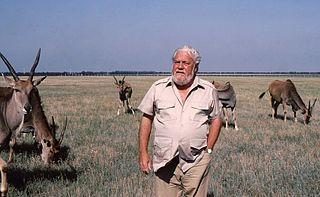
Gerald Malcolm Durrell, was a British naturalist, writer, zookeeper, conservationist, and television presenter. He founded the Durrell Wildlife Conservation Trust and the Jersey Zoo on the Channel Island of Jersey in 1959. He wrote approximately forty books, mainly about his life as an animal collector and enthusiast, the most famous being My Family and Other Animals (1956). Those memoirs of his family's years living in Greece were adapted into two television series and one television film. He was the youngest brother of novelist Lawrence Durrell.

The Mascarene Islands or Mascarenes or Mascarenhas Archipelago is a group of islands in the Indian Ocean east of Madagascar consisting of the islands belonging to the Republic of Mauritius as well as the French department of Réunion. Their name derives from the Portuguese navigator Pedro Mascarenhas, who first visited them in April 1512. The islands share a common geologic origin in the volcanism of the Réunion hotspot beneath the Mascarene Plateau and form a distinct ecoregion with a unique flora and fauna.
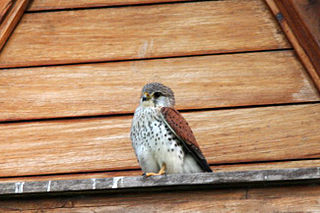
Isolated on various islands around the Indian Ocean, kestrel populations evolved into different species, like Darwin's finches. Behaviour remains similar to other small species of Falco except on (originally) forested Mauritius where kestrels hunt arboreally more like hawks. Due to the scarcity of mammals on oceanic islands, several species have adopted a diet containing many Phelsuma and other geckos. The species can be distinguished by coloration, but all except the banded kestrel share rich brown wings with black spotting. Sexes are alike in color except in the spotted kestrel, where differences are minor. As usual in birds of prey, females are larger than males; considerably so in some of these species as this assists resource partitioning.

The echo parakeet is a species of parrot endemic to the Mascarene Islands of Mauritius and formerly Réunion. It is the only living native parrot of the Mascarene Islands; all others have become extinct due to human activity. Two subspecies have been recognised, the extinct Réunion parakeet and the living echo parakeet, sometimes known as the Mauritius parakeet. The relationship between the two populations was historically unclear, but a 2015 DNA study determined them to be subspecies of the same species by comparing the DNA of echo parakeets with a single skin thought to be from a Réunion parakeet, but it has also been suggested they did not constitute different subspecies. As it was named first, the binomial name of the Réunion parakeet is used for the species; the Réunion subspecies thereby became P. eques eques, while the Mauritius subspecies became P. eques echo. Their closest relative was the extinct Newton's parakeet of Rodrigues, and the three are grouped among the subspecies of the rose-ringed parakeet of Asia and Africa.
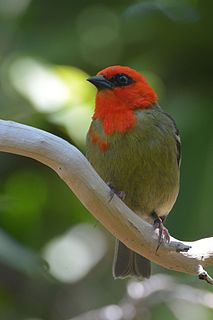
The Mauritius fody is a rare species of bird in the weaver family. It is endemic to the island of Mauritius. It is classified by BirdLife International as being endangered. It is also on the United States' Endangered Species List with an endangered status.
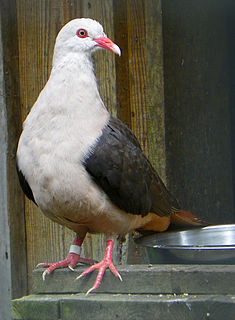
The pink pigeon is a species of pigeon in the family Columbidae endemic to Mauritius. The pink pigeon nearly became extinct in the 1970s and the 1990s and is still very rare. It is the only Mascarene pigeon that has not gone extinct. It was on the brink of extinction in 1991 when only 10 individuals remained, but its numbers have increased due to the efforts of the Durrell Wildlife Conservation Trust since 1977. While the population remains at below 500 birds as of 2011, the IUCN downlisted the species from Critically endangered to Endangered on the IUCN Red List in 2000, and then downlisted it again to Vulnerable in 2018.
The Mauritian Wildlife Foundation (MWF) is a non-governmental, non-profit conservation agency working in Mauritius to save threatened endemic local flora and fauna.
The Gerald Durrell Endemic Wildlife Sanctuary is an animal sanctuary founded in 1984, in Western Mauritius. It is an area closed off to the public, in the Black River Gorge region, which is densely forested, and is used for breeding rare, endemic Mauritian species. Among the endangered species in the sanctuary is the Mauritius kestrel, once the rarest bird in the world with only 4 members left. It has been successfully bred and the population has now reached the capacity of Mauritius.

The broad-billed parrot or raven parrot is a large extinct parrot in the family Psittaculidae. It was endemic to the Mascarene island of Mauritius in the Indian Ocean east of Madagascar. It is unclear what other species it is most closely related to, but it has been classified as a member of the tribe Psittaculini, along with other Mascarene parrots. It had similarities with the Rodrigues parrot, and may have been closely related.

The Seychelles parakeet or Seychelles Island parrot is an extinct species of parrot that was endemic to the Seychelles in the Indian Ocean. It was scientifically named Palaeornis wardi by the British ornithologist Edward Newton in 1867, and the specific name honours the British civil commissioner Swinburne Ward who procured the specimens that formed the basis for the description. It was found on the islands of Mahé, Silhouette, and possibly Praslin. Ten skin specimens exist today, but no skeletons. Though it was later moved to the genus Psittacula, genetic studies have led some researchers to suggest it should belong in a reinstated Palaeornis along with the closely related Alexandrine parakeet of Asia.

Round Island is an uninhabited islet 22.5 kilometres north of Mauritius. It has an area of 1.69 square kilometres and a maximum elevation of 280 metres. The island has been a nature reserve since 1957 and is administered jointly by the National Parks and Conservation Service and the Mauritian Wildlife Foundation. The island has been designated an Important Bird Area (IBA) by BirdLife International.

The Mascarene parrot or mascarin is an extinct species of parrot that was endemic to the Mascarene island of Réunion in the western Indian Ocean. The taxonomic relationships of this species have been subject to debate; it has historically been grouped with either the Psittaculini parrots or the vasa parrots, with the latest genetic study favouring the former group.

The Rodrigues parrot or Leguat's parrot is an extinct species of parrot that was endemic to the Mascarene island of Rodrigues in the Indian Ocean, east of Madagascar. It is unclear to which other species it is most closely related, but it is classified as a member of the tribe Psittaculini, along with other Mascarene parrots. The Rodrigues parrot bore similarities to the broad-billed parrot of Mauritius, and may have been related. Two additional species have been assigned to its genus, based on descriptions of parrots from the other Mascarene islands, but their identities and validity have been debated.

The Mauritius kestrel is a bird of prey from the family Falconidae endemic to the forests of Mauritius, where it is restricted to the southwestern plateau's forests, cliffs, and ravines. It is the most distinct of the Indian Ocean kestrels. It colonized its island home to evolve into a distinct species probably during the Gelasian . It is the most distant living species among the western Indian Ocean kestrels.
The wildlife of Mauritius consists of its flora and fauna. Mauritius is located in the Indian Ocean to the east of Madagascar. Due to its isolation, it has a relatively low diversity of wildlife; however, a high proportion of these are endemic species occurring nowhere else in the world. Many of these are now threatened with extinction because of human activities including habitat destruction and the introduction of non-native species. Some have already become extinct, most famously the dodo which disappeared in the 17th century.
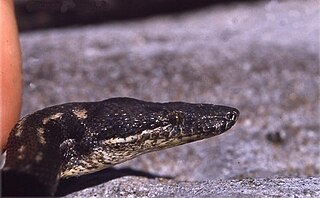
The Round Island boa, also known as the Round Island keel-scaled boa and the Round Island ground boa, is a species of nonvenomous snake in the monotypic genus Casarea in the family Bolyeriidae. The species is endemic to Round Island, Mauritius. No subspecies are currently recognized.

Black River Gorges National Park is a national park in the hilly south-western part of Mauritius. It was proclaimed on June 15, 1994 and is managed by the National Parks and Conservation Service. It covers an area of 67.54 km² including humid upland forest, drier lowland forest and marshy heathland. Facilities for visitors include two information centres, picnic areas and 60 kilometres of trails. There are four field stations in the park which are used for National Parks and Conservation Service and Mauritian Wildlife Foundation research and conservation projects.

The Mascarene grey parakeet or Thirioux's grey parrot, is an extinct species of parrot which was endemic to the Mascarene Islands of Mauritius and Réunion in the western Indian Ocean. It has been classified as a member of the tribe Psittaculini, along with other parrots from the Islands.

Ferney La Vallée is a forest and wildlife reserve situated in the Bambou mountains north of Mahébourg in Grand Port District, Mauritius. It is managed by the La Vallée de Ferney Conservation Trust.
References
- ↑ "Welcome to the Mauritian Wildlife Foundation (MWF) – About Us – Board of Directors". Mauritian-wildlife.org. 11 December 2012. Retrieved 22 November 2013.
- ↑ "Mascarenes team | Durrell Wildlife Conservation Trust". Durrell.org. 6 January 1990. Archived from the original on 3 December 2013. Retrieved 22 November 2013.
- ↑ "Carl Jones – University of East Anglia". UEA. 16 August 2012. Retrieved 22 November 2013.
- 1 2 BirdLife International (2016). "Falco punctatus". IUCN Red List of Threatened Species . 2016: e.T22696373A93557909. doi: 10.2305/IUCN.UK.2016-3.RLTS.T22696373A93557909.en . Retrieved 15 January 2020.
- ↑ Rodrigues, Ana S. L.; Brooks, Thomas M.; Butchart, Stuart H. M.; Chanson, Janice; Cox, Neil; Hoffmann, Michael; Stuart, Simon N. (26 November 2014). "Spatially Explicit Trends in the Global Conservation Status of Vertebrates". PLOS ONE. 9 (11): e113934. Bibcode:2014PLoSO...9k3934R. doi: 10.1371/journal.pone.0113934 . PMC 4245261 . PMID 25426636.
- ↑ Griffiths, CJ; Hansen, DM; Jones, CG; Zuël, N; Harris, S (2011). "Current Biology – Resurrecting Extinct Interactions with Extant Substitutes". Current Biology. 21 (9): 762–765. doi: 10.1016/j.cub.2011.03.042 . PMID 21514155.
- ↑ "BBC Two – Last Chance to See". Bbc.co.uk. 18 August 2012. Retrieved 22 November 2013.
- ↑ "Indianapolis Prize 2012 Finalist – Carl Jones" . Retrieved 22 November 2013– via YouTube.
- 1 2 "Q&A session with the two Indianapolis Prize nominees – University of Wales". Wales.ac.uk. Retrieved 22 November 2013.
- ↑ "Mauritius Kestrel (Falco punctatus) – BirdLife species factsheet". Birdlife.org. 23 March 2011. Archived from the original on 6 November 2014. Retrieved 22 November 2013.
- ↑ "Comparison of survival rates of captive-reared and wild-bred Mauritius kestrels (Falco punctatus) in a re-introduced population". Conservation Evidence. Retrieved 22 November 2013.
- ↑ "Listening to Echos and Searching for Ghosts" (PDF). Parrots.org. Retrieved 22 November 2013.
- ↑ "Echo Parakeet (Psittacula eques) - BirdLife species factsheet". Archived from the original on 8 December 2015. Retrieved 27 November 2015.
- ↑ "Pink Pigeon (Nesoenas mayeri) – BirdLife species factsheet". Birdlife.org. Retrieved 22 November 2013.
- ↑ "Pink Pigeon (Nesoenas mayeri) - BirdLife species factsheet". Archived from the original on 3 December 2013. Retrieved 14 October 2013.
- ↑ Jones, Carl (November 1998). On the Edge, no. 83. Case Study: Reptile Recovery on Round Island. Durrell Wildlife Conservation Trust. ISBN 9780851995694 . Retrieved 1 November 2015.
- ↑ "Birdlife Data Zone". birdlife.org. Retrieved 27 November 2015.
- ↑ "Conservation training courses – Durrell Conservation Academy". durrell.org. Archived from the original on 20 February 2014. Retrieved 27 November 2015.
- ↑ "New Year Honours for Carl Jones". durrell.org. 14 January 2004.
- ↑ "Durrell's Carl Jones Nominated for the 2012 Indianapolis Prize". durrell.org. 22 November 2011.
- ↑ "Welsh biologist Carl Jones wins top environmental award". The Guardian. 4 May 2016. Retrieved 4 May 2016.